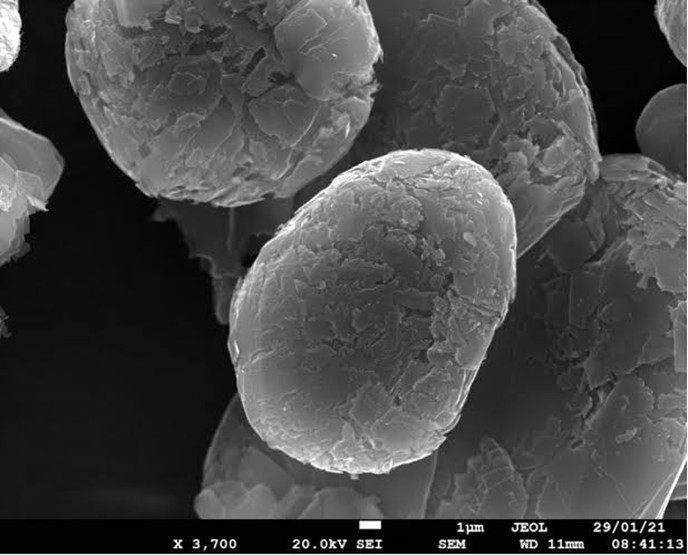New Funding Sparks Opportunities for Battery-Grade Graphite Development
The Commonwealth Scientific and Industrial Research Organisation (CSIRO) has unveiled a $400,000 graphite R&D grant program aimed at accelerating breakthroughs in graphite processing and application for the battery industry. The initiative is particularly geared toward small-to-medium enterprises (SMEs) in Australia, reflecting the federal government’s broader commitment to strengthening the nation’s position in the critical minerals and energy storage value chain.
The program seeks to address key technical barriers in producing battery-grade graphite, particularly for use in lithium-ion batteries, where Australia currently lags in downstream capabilities despite abundant raw material reserves.

CSIRO scientists conducting electrochemical testing on purified graphite samples.
Source: ResearchGate
CSIRO Graphite R&D Grant: Targeting Purity and Performance
The CSIRO graphite R&D grant will focus on two critical technical aspects: graphite spheronisation and graphite purification, both of which are essential for enhancing graphite’s electrochemical performance in battery anodes.
Participating SMEs will be able to access CSIRO’s state-of-the-art research infrastructure and expertise in electrochemical testing, enabling them to validate their material’s suitability for commercial battery applications.
“We’re aiming to close the gap between raw graphite producers and high-value battery-grade output,” said Dr. Adam Best, a senior research scientist at CSIRO’s Energy division. “This grant provides Australian SMEs with a chance to bring lab-scale innovation closer to market.”
Graphite in Lithium-Ion Batteries: Why It Matters
Graphite is the dominant material used in lithium-ion battery anodes, with every electric vehicle battery pack containing up to 70 kilograms of graphite. However, over 90% of the world’s synthetic graphite supply is currently controlled by China, raising geopolitical and supply chain concerns.
By enhancing local capabilities in graphite purification and spheronisation, CSIRO hopes to boost Australia’s role in the midstream segment of the critical minerals industry and reduce reliance on imported materials for battery cell manufacturing.
The project complements other national efforts to diversify and secure future-facing supply chains—especially those tied to the electrification of transport and renewable energy integration.
Caption: Graphite spheronisation under SEM analysis at CSIRO battery labs.
Source: CSIRO
$400,000 to Drive Real-World Innovation
The program will provide up to $400,000 in direct funding, distributed across selected SMEs in the form of project-specific grants. Each grant will support bespoke R&D activity, which may include:
- Raw material evaluation and characterization
- High-temperature purification trials
- Spheronisation process optimisation
- Electrochemical testing for battery performance
- Scale-up feasibility assessment for pilot production
The funding also includes in-kind support from CSIRO, such as access to clean labs, test rigs, and data analysis from its specialist battery testing team.
“This grant is designed to help Australian innovators translate lab insights into industrial capability,” said CSIRO’s Minerals Resources Director, Dr. Larry Marshall. “We want to see more SMEs succeed in this space and scale into the global battery supply chain.”
Strengthening Australia’s Critical Mineral Ecosystem
This graphite R&D initiative arrives as Australia accelerates its national strategy to become a global powerhouse in critical minerals, which include not only graphite but also lithium, cobalt, rare earth elements, and vanadium. By supporting SMEs with high-potential technologies, the CSIRO is attempting to stimulate local processing capacity and attract private capital for midstream manufacturing.
The program also supports Australia’s Net Zero 2050 roadmap, aligning with government goals to electrify transport, modernise energy grids, and strengthen local supply chains for clean technologies.
Also Read: WA vs QLD: Which State Will Dominate Critical Mineral Exports in 2025?
Industry Reaction and What Comes Next
News of the CSIRO graphite R&D grant has been well-received by industry leaders and materials tech entrepreneurs, who often cite the lack of funding access as a major hurdle for scale-up. For many, the ability to collaborate directly with CSIRO could be transformative.
“This is the kind of targeted support that gives Australian SMEs a fighting chance in a globalised materials market,” said a spokesperson from a Western Australian battery start-up.
Applications for the grant are now open, with shortlisted companies expected to begin lab trials in Q3 2025. Results from the first round of funded projects could be published as early as mid-2026, offering a clearer picture of how domestic graphite can meet international battery standards.
Conclusion: A Critical Boost for Critical Minerals
The CSIRO graphite R&D grant is more than just financial support—it’s a strategic investment in Australia’s technological sovereignty and its transition to a clean energy economy. By enabling SMEs to close the technical gap between mined graphite and battery-grade products, the initiative may play a pivotal role in reshaping the country’s position in the global battery ecosystem.


